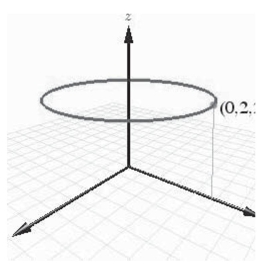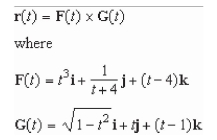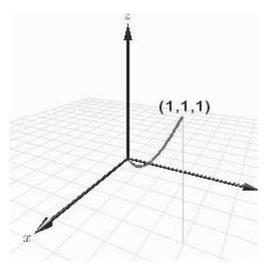A) ![]()
B) ![]()
C) ![]()
D) ![]()
E) ![]()
Correct Answer

verified
Correct Answer
verified
Multiple Choice
Evaluate the definite integral below. 
A) ![]()
B) ![]()
C) ![]()
D) ![]()
E) ![]()
Correct Answer

verified
Correct Answer
verified
Multiple Choice
Find the open interval on which the curve given by the vector-valued function  is smooth.
is smooth.
A) ![]()
B) ![]()
C) ![]()
D) ![]()
E) ![]()
Correct Answer

verified
Correct Answer
verified
Multiple Choice
Use the properties of the derivative to find  given the following vector-valued functions.
given the following vector-valued functions. 
A) ![]()
B) ![]()
C) ![]()
D) ![]()
E) ![]()
Correct Answer

verified
Correct Answer
verified
Multiple Choice
Find a vector-valued function, using the given parameter, to represent the intersection of the surfaces given below. 
A) ![]()
B) ![]()
C) ![]()
D) ![]()
E) ![]()
Correct Answer

verified
Correct Answer
verified
Multiple Choice
The graph below is most likely the graph of which of the following equations? 
A) ![]()
B) ![]()
C) ![]()
D) ![]()
E) ![]()
Correct Answer

verified
Correct Answer
verified
Multiple Choice
Sketch the curve represented by the vector-valued function  and give the orientation of the curve.
and give the orientation of the curve.
A) ![]()
B) ![]()
C) ![]()
D) ![]()
E) ![]()
Correct Answer

verified
Correct Answer
verified
Multiple Choice
Evaluate the limit given below. 
A) ![]()
B) ![]()
C) ![]()
D) ![]()
E) The limit does not exist.
Correct Answer

verified
Correct Answer
verified
Multiple Choice
Find  given the following vector function.
given the following vector function. 
A) ![]()
B) ![]()
C) ![]()
D) ![]()
E) ![]()
Correct Answer

verified
Correct Answer
verified
Multiple Choice
Find the domain of the vector-valued function given below. 
A) ![]()
B) ![]()
C) ![]()
D) ![]()
E) ![]()
Correct Answer

verified
Correct Answer
verified
Multiple Choice
 given the functions below.
given the functions below. 
A) ![]()
B) ![]()
C) ![]()
D) ![]()
E) ![]()
Correct Answer

verified
Correct Answer
verified
Multiple Choice
Find a vector-valued function, using the given parameter, to represent the intersection of the surfaces given below. 
A) ![]()
B) ![]()
C) ![]()
D) ![]()
E) ![]()
Correct Answer

verified
Correct Answer
verified
Multiple Choice
Match the equation with the graph shown in red below. 
A) ![]()
B) ![]()
C) ![]()
D) ![]()
E) ![]()
Correct Answer

verified
Correct Answer
verified
Multiple Choice
Evaluate the limit given below. 
A) ![]()
B) ![]()
C) ![]()
D) ![]()
E) The limit does not exist.
Correct Answer

verified
Correct Answer
verified
Multiple Choice
Find a vector-valued function, using the given parameter, to represent the intersection of the surfaces given below. 
A) ![]()
B) ![]()
C) ![]()
D) ![]()
E) ![]()
Correct Answer

verified
Correct Answer
verified
Multiple Choice
Use the properties of the derivative to find  given the following vector-valued functions.
given the following vector-valued functions. 
A) ![]()
B) ![]()
C) ![]()
D) ![]()
E) ![]()
Correct Answer

verified
Correct Answer
verified
Multiple Choice
Sketch the curve represented by the vector-valued function  give the orientation of the curve.
give the orientation of the curve.
A) ![]()
B) ![]()
C) ![]()
D) ![]()
E) ![]()
Correct Answer

verified
Correct Answer
verified
Showing 21 - 37 of 37
Related Exams